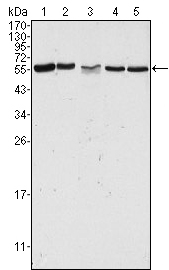PAKγ Monoclonal Antibody
- Catalog No.:YM0502
- Applications:WB;IHC;IF;ELISA
- Reactivity:Human;Monkey
- Target:
- PAK2
- Fields:
- >>MAPK signaling pathway;>>ErbB signaling pathway;>>Ras signaling pathway;>>Axon guidance;>>Focal adhesion;>>T cell receptor signaling pathway;>>Regulation of actin cytoskeleton;>>Pathogenic Escherichia coli infection;>>Human immunodeficiency virus 1 infection;>>Renal cell carcinoma
- Gene Name:
- PAK2
- Protein Name:
- Serine/threonine-protein kinase PAK 2
- Human Gene Id:
- 5062
- Human Swiss Prot No:
- Q13177
- Mouse Swiss Prot No:
- Q8CIN4
- Immunogen:
- Purified recombinant fragment of PAKγ expressed in E. Coli.
- Specificity:
- PAKγ Monoclonal Antibody detects endogenous levels of PAKγ protein.
- Formulation:
- Liquid in PBS containing 50% glycerol, 0.5% BSA and 0.02% sodium azide.
- Source:
- Monoclonal, Mouse
- Dilution:
- WB 1:500 - 1:2000. IHC 1:200 - 1:1000. IF 1:200 - 1:1000. ELISA: 1:10000. Not yet tested in other applications.
- Purification:
- Affinity purification
- Storage Stability:
- -15°C to -25°C/1 year(Do not lower than -25°C)
- Other Name:
- PAK2;Serine/threonine-protein kinase PAK 2;Gamma-PAK;PAK65;S6/H4 kinase;p21-activated kinase 2;PAK-2;p58
- Molecular Weight(Da):
- 58kD
- References:
- 1. J Immunol. 2004 Jun 15;172(12):7324-34.
2. J Mol Biol. 2007 Jul 20;370(4):620-32.
- Background:
- The p21 activated kinases (PAK) are critical effectors that link Rho GTPases to cytoskeleton reorganization and nuclear signaling. The PAK proteins are a family of serine/threonine kinases that serve as targets for the small GTP binding proteins, CDC42 and RAC1, and have been implicated in a wide range of biological activities. The protein encoded by this gene is activated by proteolytic cleavage during caspase-mediated apoptosis, and may play a role in regulating the apoptotic events in the dying cell. [provided by RefSeq, Jul 2008],
- Function:
- catalytic activity:ATP + a protein = ADP + a phosphoprotein.,enzyme regulation:Activated by binding small G proteins. Binding of GTP-bound CDC42 or RAC1 to the autoregulatory region releases monomers from the autoinhibited dimer, enables phosphorylation of Thr-402 and allows the kinase domain to adopt an active structure (By similarity). Following caspase cleavage, autophosphorylted PAK-2p34 is constitutively active.,function:The activated kinase acts on a variety of targets. Phosphorylates ribosomal protein S6, histone H4 and myelin basic protein. Full length PAK 2 stimulates cell survival and cell growth. The process is, at least in part, mediated by phosphorylation and inhibition of pro-apoptotic BAD. Caspase-activated PAK-2p34 is involved in cell death response, probably involving the JNK signaling pathway. Cleaved PAK-2p34 seems to have a higher activity than the CDC42-activated for
- Subcellular Location:
- [Serine/threonine-protein kinase PAK 2]: Cytoplasm. MYO18A mediates the cellular distribution of the PAK2-ARHGEF7-GIT1 complex to the inner surface of the cell membrane.; [PAK-2p34]: Nucleus. Cytoplasm, perinuclear region. Membrane; Lipid-anchor. Interaction with ARHGAP10 probably changes PAK-2p34 location to cytoplasmic perinuclear region. Myristoylation changes PAK-2p34 location to the membrane.
- Expression:
- Ubiquitously expressed. Higher levels seen in skeletal muscle, ovary, thymus and spleen.
- June 19-2018
- WESTERN IMMUNOBLOTTING PROTOCOL
- June 19-2018
- IMMUNOHISTOCHEMISTRY-PARAFFIN PROTOCOL
- June 19-2018
- IMMUNOFLUORESCENCE PROTOCOL
- September 08-2020
- FLOW-CYTOMEYRT-PROTOCOL
- May 20-2022
- Cell-Based ELISA│解您多样本WB检测之困扰
- July 13-2018
- CELL-BASED-ELISA-PROTOCOL-FOR-ACETYL-PROTEIN
- July 13-2018
- CELL-BASED-ELISA-PROTOCOL-FOR-PHOSPHO-PROTEIN
- July 13-2018
- Antibody-FAQs
- Products Images

- Western Blot analysis using PAKγ Monoclonal Antibody against HeLa (1), Jurkat (2), A549 (3), HEK293 (4) and K562 (5) cell lysate.

- Immunohistochemistry analysis of paraffin-embedded human lung cancer (left) and gastric cancer (right) with DAB staining using PAKγ Monoclonal Antibody.

- Confocal immunofluorescence analysis of Hela cells using PAKγ Monoclonal Antibody (green). Blue: DRAQ5 fluorescent DNA dye.



